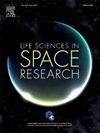Combined irradiation by gamma-rays and carbon-12 nuclei caused hyperlocomotion and change in striatal metabolism of rats
IF 2.8
3区 生物学
Q2 ASTRONOMY & ASTROPHYSICS
引用次数: 0
Abstract
Exposure to ionizing radiation during manned deep space missions to Mars could lead to functional impairments of the central nervous system, which may compromise the success of the mission and affect the quality of life for returning astronauts. Along with radiation-induced changes in cognitive abilities and emotional status, the effects of increased motor activity were observed. The mechanisms behind these phenomena still remain unresolved. We conducted a study on grip strength, locomotor activity and intrasession habituation to novelty in 5-month-old rats after exposure to radiation (combined 0.4 Gy gamma-rays and 0.14 Gy 12C nuclei). At the same time, we carried out neurochemical and molecular analysis of the nucleus accumbens (NAc) and the dorsal striatum (dST). The study revealed radiation-induced hyperlocomotion and enhanced habituation. It also showed an increase in choline concentration and a decreased in 5-hydroxyindoleacetic acid concentration in the NAc after irradiation. In addition to this, a down-regulation of syntaxin 1A in NAc and dST as well as up-regulation α-synuclein in NAc were observed. The obtained data indicate both the damaging effect of irradiation on striatum tissues and the initiation of neuronal/axonal regeneration processes. It is hypothesized that the increase in choline concentration in NAc and the decreased content of syntaxin 1A in dST may be the part of the mechanism responsible for the radiation-induced hyperlocomotion.
伽马射线和碳-12核的联合照射导致大鼠运动过度和纹状体代谢改变
在载人深空火星任务中暴露于电离辐射可能会导致中枢神经系统功能受损,这可能会危及任务的成功并影响返回宇航员的生活质量。除了辐射引起的认知能力和情绪状态的变化外,还观察到运动活动增加的影响。这些现象背后的机制仍未解决。我们对 5 个月大的大鼠暴露于辐射(0.4 Gy 伽马射线和 0.14 Gy C 核)后的握力、运动活动和对新事物的期中习惯进行了研究。同时,我们还对大鼠的伏隔核(NAc)和背纹状体(dST)进行了神经化学和分子分析。研究显示,辐射诱导了过度运动和习惯性增强。研究还显示,辐照后 NAc 中胆碱浓度升高,5-羟基吲哚乙酸浓度降低。此外,还观察到NAc和dST中的合成蛋白1A下调,以及NAc中的α-突触核蛋白上调。所获得的数据表明,辐照对纹状体组织具有破坏作用,同时也启动了神经元/轴突的再生过程。据此推测,NAc中胆碱浓度的增加和dST中突触素1A含量的减少可能是辐射诱导超运动的部分机制。
本文章由计算机程序翻译,如有差异,请以英文原文为准。
求助全文
约1分钟内获得全文
求助全文
来源期刊

Life Sciences in Space Research
Agricultural and Biological Sciences-Agricultural and Biological Sciences (miscellaneous)
CiteScore
5.30
自引率
8.00%
发文量
69
期刊介绍:
Life Sciences in Space Research publishes high quality original research and review articles in areas previously covered by the Life Sciences section of COSPAR''s other society journal Advances in Space Research.
Life Sciences in Space Research features an editorial team of top scientists in the space radiation field and guarantees a fast turnaround time from submission to editorial decision.
 求助内容:
求助内容: 应助结果提醒方式:
应助结果提醒方式:


